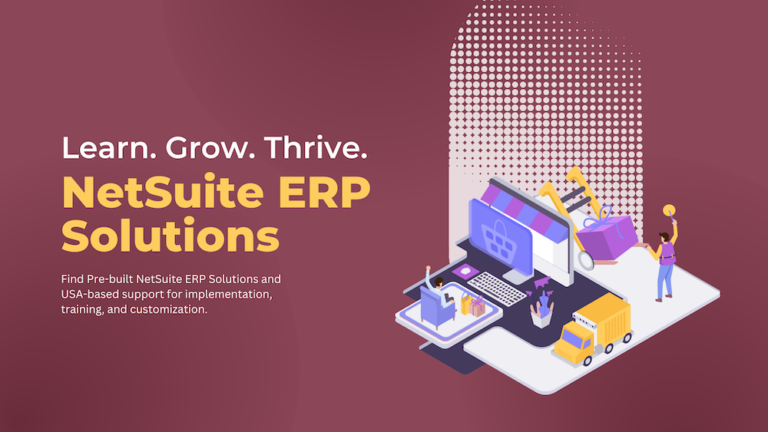Enterprise Resource Planning (ERP) systems are pivotal in streamlining and consolidating business operations across departments. These software solutions offer powerful functionalities to manage various processes, including finance, customer relationship management (CRM), e-commerce, inventory, human resources, and more. With the myriad of ERP systems available today, choosing the right solution for your business can be daunting. One of the industry leaders in ERP is Oracle’s NetSuite. However, it competes with many other ERPs, each having unique strengths and weaknesses.
This blog post aims to compare NetSuite ERP and some of its key competitors comprehensively: SAP Business One, Microsoft Dynamics 365, and Sage Intacct. Our objective is to assist you in making an informed decision about which ERP best suits your business needs.
NetSuite ERP
NetSuite ERP, a cloud-based ERP solution, is widely recognized for its robustness and scalability. It’s a complete suite integrates various business functions, including financial management, order management, production, supply chain, procurement, and warehouse and fulfillment. As a cloud-first solution, it is also designed to be accessible from any device, anywhere, making it a good choice for businesses that need flexibility and mobility.
Strengths
- Scalability: NetSuite ERP can quickly scale your business as it grows. Whether you are a small company or a multinational corporation, it can accommodate your needs.
- Integration: Its seamless integration with other NetSuite products like CRM, e-commerce, and professional services automation (PSA) offers a comprehensive, unified platform.
- Cloud-first approach: As a cloud-based system, NetSuite offers real-time data access, remote accessibility, automatic updates, and a reduced need for in-house IT infrastructure.
- Customization and extensibility: With the SuiteCloud platform, businesses can customize and extend NetSuite to meet their specific requirements.
Weaknesses
- Cost: NetSuite can be expensive compared to other ERP solutions, particularly for small businesses.
- Complexity: While its extensive features can be advantageous, they also contribute to a steep learning curve, particularly for users without ERP experience.
SAP Business One
SAP Business One, an ERP solution from the software giant SAP, is designed specifically for small and mid-sized businesses. It offers financial management, sales, and customer management, purchasing and inventory control, business intelligence, and more functionalities.
Strengths
- Robust financial management features: SAP Business One shines in its financial management capabilities, including accounting, fixed asset management, cost controlling, and budgeting.
- Integration with SAP products: It integrates smoothly with other SAP products, providing a broader range of services and continuity for businesses already using SAP software.
- Industry-specific solutions: SAP Business One offers industry-specific features for sectors like manufacturing, retail, service, and distribution.
Weaknesses
- Limited scalability: While excellent for small and medium-sized businesses, SAP Business One may not scale effectively for more giant corporations.
- Less intuitive user interface: Users often find the system’s interface less modern and intuitive than competitors like NetSuite.
Microsoft Dynamics 365
Microsoft Dynamics 365 is a comprehensive cloud-based ERP and CRM solution. It offers sales, customer service, field service, operations, financials, marketing, and project service automation modules.
Strengths
- Integration with Microsoft ecosystem: Dynamics 365 integrates seamlessly with other Microsoft products like Office 365, Power BI, and Azure, creating a cohesive and familiar user ecosystem.
- Flexibility: With its modular structure, businesses can pick and choose which functionalities they need, allowing for a more tailored and cost-effective solution.
- AI-powered insights: Dynamics 365 leverages Microsoft’s AI capabilities to offer predictive insights and analytics.
Weaknesses
- Complex pricing structure: Modular pricing can be confusing and potentially expensive if businesses require multiple modules.
- Usability: While it has improved over the years, some users report that the system is not as user-friendly as some competitors.
Sage Intacct
Sage Intacct is a cloud-based financial management and accounting software. It is well-regarded for its robust financial features, making it an ideal choice for businesses primarily focused on advanced financial management.
Strengths
- Advanced financial features: Sage Intacct offers robust financial management capabilities, including cash management, contract and subscription billing, project accounting, and multi-entity and multi-currency management.
- Integration: It integrates with other Sage products and a broad range of other software, offering flexibility in creating a comprehensive business management solution.
- User-friendly interface: Users often appreciate its intuitive and modern interface.
Weaknesses
- Limited broader ERP functionality: While it excels in financial management, Sage Intacct does not offer the same breadth of features as full-suite ERP solutions like NetSuite or Dynamics 365.
- Scalability: While it can handle the needs of many businesses, it may not scale as effectively as some of its competitors for substantial companies or those with complex needs.
- While it can handle the needs of many businesses, it may not scale as effectively as some of Sage’s alternative software , such as Xerox, for substantial businesses or those with complex needs.
Conclusion
Each of these ERP solutions has its unique strengths and weaknesses. While NetSuite offers a comprehensive and scalable solution, its cost and complexity may deter some businesses. SAP Business One and Sage Intacct provide robust financial management features, but their scalability is more limited. Microsoft Dynamics 365 offers flexibility and integration with the Microsoft ecosystem, but its pricing structure and usability can be challenges.
Choosing the right ERP system depends on your business size, industry, specific needs, and budget. It’s crucial to assess your requirements and evaluate each solution accordingly thoroughly. A well-chosen ERP system will streamline your operations, improve efficiency, and drive business growth.
Also, Read The Following: GOLO lawsuit


